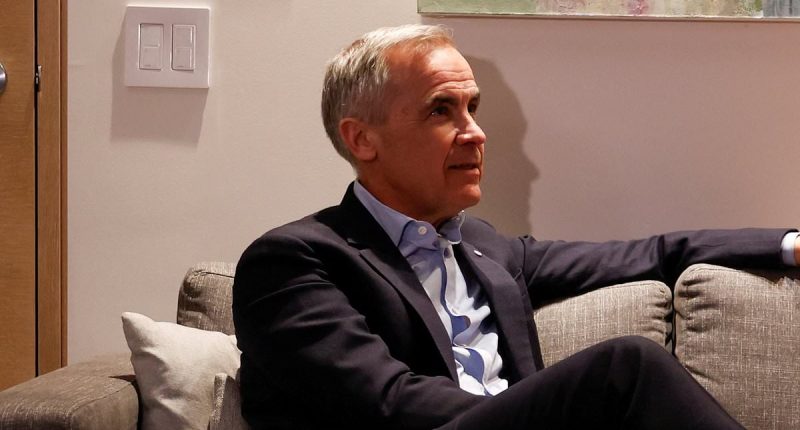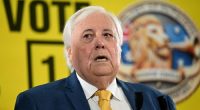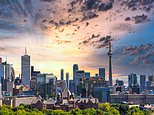Share this @internewscast.com
Prime Minister Mark Carney is projected to continue to rule Canada after being declared winner of Monday’s elections.
His Liberal Party completed a shocking comeback driven by anger toward Donald Trump, though its too soon to say whether they will be forming a majority or minority government in Canada’s parliamentary system.
It means that Carney will remain in charge of dealing with an American president in Donald Trump who has openly gloated about making the neighbors to the north the ’51st state’ and calling his predecessor ‘Governor [Justin] Trudeau.’
The U.S. president trolled Canadians on election day by suggesting on social media that he was in fact on the ballot and repeating that Canada should become the 51st state, incorrectly claiming the U.S. subsidizes Canada.
‘It makes no sense unless Canada is a State!’ Trump wrote.
Canada’s system requires either a majority of 172 parliamentary seats or a coalition government between one of the two major parties – the Liberals and Conservatives – and one of a few smaller parties.
Prognosticators have said its too soon to tell if Carney’s Liberals will have more than 172 seats but they would be likely to form a coalition with the far left New Democrat Party or the Quebec-centric Bloc Quebecois to form a ruling government.
As of 12:30 a.m. EDT, Liberals were leading in 162 of 343 districts (up from 150 in the previous government), with Conservatives leading in 148. Bloc Quebecois leads in 23 (down from 33), while the NDP leads in eight (down from 24) and the Green Party in one (unchanged), according to CBC.

Canada’s Prime Minister Mark Carney (pictured left) and his wife Diana Fox Carney (pictured right) watch the coverage of the election results at a hotel in downtown Ottawa

Canada ‘s ruling Liberals retained power in Monday’s election but it is too soon to say whether they will form a majority government over Pierre Poilievre’s (pictured) Conservatives
The Liberals looked headed for a crushing defeat until the American president started attacking Canada´s economy and threatening its sovereignty, suggesting it should become the 51st state.
Trump´s actions infuriated Canadians and stoked a surge in nationalism that helped the Liberals flip the election narrative and win a fourth-straight term in power.
The opposition Conservative Party´s leader, Pierre Poilievre, hoped to make the election a referendum on former Prime Minister Justin Trudeau, whose popularity declined toward the end of his decade in power as food and housing prices rose.
If the Conservative Party won all 149 districts its currently leading, that would still mark an increase of 29 seats from the previous government.
But Trump attacked, Trudeau resigned and Carney, a two-time central banker, became the Liberal Party´s leader and prime minister.
Trump´s truculence has infuriated many Canadians, leading many to cancel U.S. vacations, refuse to buy American goods and possibly even vote early.
A record 7.3 million Canadians cast ballots before election day.
Trump’s attacks also put Poilievre and the opposition Conservative Party on the defensive and led to a surge in nationalism that helped the Liberals flip the election narrative.

Supporters for Canada’s Prime Minister and Liberal Party leader Mark Carney celebrates as results are announced
![Carney will remain in charge of dealing with an American president in Donald Trump (pictured right) who has openly gloated about making the neighbors to the north the '51st state' and calling his predecessor 'Governor [Justin] Trudeau' (pictured left)](https://i.dailymail.co.uk/1s/2025/04/29/03/97802849-14657373-image-a-19_1745893198774.jpg)
Carney will remain in charge of dealing with an American president in Donald Trump (pictured right) who has openly gloated about making the neighbors to the north the ’51st state’ and calling his predecessor ‘Governor [Justin] Trudeau’ (pictured left)

The president bragged about his effect on the Canadian election and how he’d hurt Poilievre in an interview with The Atlantic published Monday.
‘You know, until I came along, remember that the conservative was leading by 25 points,’ Trump said.
‘Then I was disliked by enough of the Canadians that I’ve thrown the election into a close call, right? I don’t even know if it’s a close call,’ he added.
DailyMail.com has reached out to the White House for comment.
Prime Minister Mark Carney had asked for a strong mandate to help him handle Trump’s tariffs and annexation threat but CBC said the Liberals had not yet secured the 172 electoral districts, known as seats, they needed for a majority.
Conservative Party leader Pierre Poilievre was considered the frontrunner consistent with the rise in anti-incumbent party sentiment at the start of the year. Trudeau and his Liberal Party had been in power for nearly a decade.
Poilievre had run on a MAGA-style platform, promising tax cuts, complaining about immigration and dipping his toe into culture war issues.
The full result might not be known for some time and could depend on the westernmost province of British Columbia, where polls closed last.

Carney and the Liberals cleared a big hurdle by winning a fourth-straight term, but they have daunting challenges ahead
Carney had promised a tough approach with Washington over its tariffs and said Canada would need to spend billions to reduce its reliance on the United States.
But the right-of-center Conservatives, who called for change after more than nine years of Liberal rule, showed unexpected strength.
The last party to win four consecutive elections in Canada was the Liberals, in 2004.
The result was a huge defeat for Conservative leader Poilievre, who focused his campaign on domestic issues and the need to fix a country the Liberals had ‘broken.’
Trump reinserted himself into Canada´s election during a signing ceremony inside the Oval Office, saying Canada ‘would cease to exist as a country’ if the U.S. stopped buying its goods.
‘I have to be honest, as a state, it works great,’ said Trump, who previously threatened to make the country the 51st state through economic coercion.
Trump reiterated his claim that the U.S. doesn´t need anything from Canada – including autos and oil.
Carney and the Liberals cleared a big hurdle by winning a fourth-straight term, but they have daunting challenges ahead.

Dorothy Goubault, a supporter of Canada’s Prime Minister Mark Carney, reacts to polling numbers at the Liberal Party election night headquarters in Ottawa

Amanda Mainville, a government worker and supporter of Conservative Party of Canada’s leader Pierre Poilievre, reacts as news media calls the election for the Liberal Party
Foreign policy hadn´t dominated a Canadian election as much as it did this year’s since 1988, when, ironically, free trade with the United States was the prevailing issue.
In addition to the trade war with the U.S. and frosty relationship with Trump, Canada is dealing with a cost-of-living crisis.
And more than 75% of its exports go to the U.S., so Trump’s tariffs threat and his desire to get North American automakers to move Canada’s production south could severely damage the Canadian economy.
While campaigning, Carney vowed that every dollar the the government collects from counter-tariffs on U.S. goods will go toward Canadian workers who are adversely affected by the trade war.
He also said he plans to keep dental care in place, offer a middle-class tax cut, return immigration to sustainable levels and increase funding to Canada’s public broadcaster, the Canadian Broadcasting Corporation.








